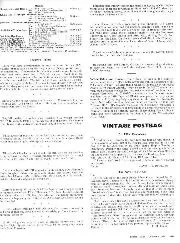
An ERA conundrum
Sir, According to my records, the only time the four drivers, shown in the photograph on page 810 of the August issue, appeared in the same race driving E.R.A.'s, was…
It’s been dubbed ‘the most famous car in the world’. It’s not clear who said as much but, whether or not such claims are true, there’s little doubt that the Aston Martin DB5 is one of the most desirable vehicles of all time.
The British manufacturer has Eon Productions, the owner of the James Bond franchise, to thank for that. Giving the quintessential Bond Sean Connery a gadget-laden DB5 to drive in Goldfinger and then Thunderball secured the Aston grand tourer a place in the consciousness of the wider public. Cameos in later post-Connery Bond films, a big-selling Corgi model and now the official continuation car, announced last year, mean that everyone can identify ‘007’s Aston’, even if they can’t quite conjure the model name.
Bond didn’t drive a DB5 in Ian Fleming’s novel. He couldn’t, of course, because the book that shares its name with the movie was published five years before the car’s 1963 launch. In the book, his MI6-issue vehicle — complete with machine guns, revolving number plates, ejector seat et al — was an Aston DB MkIII, so it was only right that in Goldfinger released in 1964 that 007 should drive its mid-60s successor.
The car Fleming chose for Bond, correctly called the DB2/4 MkIII, was superseded in 1959 by the DB4, the first Aston to be built at the famous Newport Pagnell factory that remains in Aston’s hands to this day. The DB5 continued the development trend on its arrival four years later. It was more GT than sports car, a roomier vehicle with added creature comforts.
The DB5 wasn’t really a new machine, rather a revamp of the final DB4 Series V. It retained its live rear axle after a De Dion semi-independent system was considered and discarded. The all-aluminium, straight-six overhead-cam engine was enlarged from 3.7 to four litres, increasing power by 40 or so horses and, apart from the very earliest cars, a ZF five-speed gearbox replaced the four-cog David Brown transmission.
And it was all clothed in ever-more alluring aluminium Superleggera coachwork designed by Carrozzeria Touring in Italy. The DB5 wins hands down over both its predecessors and its successor, the 1965 DB6, in any DB beauty contest.
“Maybe this is even the definitive Aston Martin, at least in silver”
Refinements found inside included electric windows for the first time and the option of air-conditioning. An automatic Borg-Warner transmission was a no-cost option.
As with its predecessor, there was a high-performance Vantage model with some 40bhp more due to uprated carburettors and reprofiled camshafts. And there was also a short run of convertibles, and even a shooting brake, originally a one-off to facilitate the hobbies of Aston boss David Brown, a hunting, shooting and fishing fan.
It is the two-plus-two coupé that is the definitive DB5, perhaps because it was driven by the definitive Bond. Maybe this is even the definitive Aston Martin, at least in silver.
There isn’t a record of how many of the 1500 or so DB5s built were delivered in what was officially known as Silver Birch. Aston, don’t forget, had a chequered history through much of the 1970s and into the ’80s, going bust on one occasion. But marque experts contend the shade it was not the most common choice of the time.
It’s also impossible to know just how many of the remaining DB5s are presently resplendent in Silver Birch. The likelihood is that it’s a sizeable majority. If you have the money to own one, you want it to look just like Bond’s – the most famous car in the world.
Aston Martin DB5
• Price new £4248 (inc taxes)
• Price now £550,000 to £1 million
• Engine 4.0-litre 12-valve straight six
• Power 282bhp
• 0-60mph 7.1sec
• Top speed 145mph
• Rivals Jaguar E-type, Ferrari 275 GTB
• Verdict The quintessential Englishman’s tourer
A cocktail of speed, comfort and versatility
It is hard to imagine a more quintessentially British sports car than the Aston Martin DB5, a style icon and a true driver’s car.
A development of the DB4, this model took a successful formula, light Carrozzeria Touring body, wonderfully powerful straight six, and refined it.
With the ability to outpace all but the finest of its Italian super car rivals, while simultaneously carrying four passengers and luggage, there were few finer choices for a wealthy clientele.
The DB5 has today become one of the truly great collector’s cars. Prices have risen keenly over the last decade, helped in no small part by the world-famous James Bond connection. The film producers had wanted Bond to drive a Jaguar E-type, but the firm declined to lend any vehicles and Aston thus stepped in.
A regular saloon in average condition should hover around the £400,000 mark, but prices can double for a Vantage. At the top of the chain is the DB5 drop-head coupé, for which a buyer will expect to pay at least £1.2 million. Beyond that there is the ultra-rare DB short-chassis Volante, which can easily fetch more than twice as much as a DHC at auction. The owners of such wonderful vehicles consider them to be worth every penny…
David Bond, managing director, Footman James
